10.1: Pre-Islamic Arabia
10.1.1: The Nomadic Tribes of Arabia
The nomadic pastoralist Bedouin tribes inhabited the Arabian Peninsula before the rise of Islam around 700 CE.
Learning Objective
Describe the societal structure of tribes in Arabia
Key Points
- Nomadic Bedouin tribes dominated the Arabian Peninsula before the rise of Islam.
- Family groups called clans formed larger tribal units, which reinforced family cooperation in the difficult living conditions on the Arabian peninsula and protected its members against other tribes.
- The Bedouin tribes were nomadic pastoralists who relied on their herds of goats, sheep, and camels for meat, milk, cheese, blood, fur/wool, and other sustenance.
- The pre-Islamic Bedouins also hunted, served as bodyguards, escorted caravans, worked as mercenaries, and traded or raided to gain animals, women, gold, fabric, and other luxury items.
- Arab tribes begin to appear in the south Syrian deserts and southern Jordan around 200 CE, but spread from the central Arabian Peninsula after the rise of Islam in the 630s CE.
Key Terms
- Nabatean
-
an ancient Semitic people who inhabited northern Arabia and Southern Levant, ca. 37–100 CE.
- Bedouin
-
a predominantly desert-dwelling Arabian ethnic group traditionally divided into tribes or clans.
Pre-Islamic Arabia
Pre-Islamic Arabia refers to the Arabian Peninsula prior to the rise of Islam in the 630s.
Some of the settled communities in the Arabian Peninsula developed into distinctive civilizations. Sources for these civilizations are not extensive, and are limited to archaeological evidence, accounts written outside of Arabia, and Arab oral traditions later recorded by Islamic scholars. Among the most prominent civilizations were Thamud, which arose around 3000 BCE and lasted to about 300 CE, and Dilmun, which arose around the end of the fourth millennium and lasted to about 600 CE. Additionally, from the beginning of the first millennium BCE, Southern Arabia was the home to a number of kingdoms, such as the Sabaean kingdom, and the coastal areas of Eastern Arabia were controlled by the Iranian Parthians and Sassanians from 300 BCE.
Pre-Islamic religion in Arabia consisted of indigenous polytheistic beliefs, Ancient Arabian Christianity, Nestorian Christianity, Judaism, and Zoroastrianism. Christianity existed in the Arabian Peninsula, and was established first by the early Arab traders who heard the gospel from Peter the apostle at Jerusalem (Acts 2:11), as well as those evangelized by Paul’s ministry in Arabia (Galatians 1:17) and by St Thomas. While ancient Arabian Christianity was strong in areas of Southern Arabia, especially with Najran being an important center of Christianity, Nestorian Christianity was the dominant religion in Eastern Arabia prior to the advent of Islam.
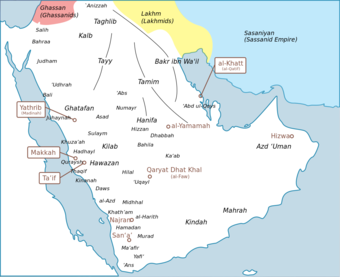
Tribes in the Arabian Peninsula c. 600 CE
Approximate locations of some of the important tribes and Empire of the Arabian Peninsula before the dawn of Islam. Family groups called clans formed larger tribal units, which reinforced family cooperation in the difficulty living conditions on the Arabian peninsula and protected its members against other tribes.
Nomadic Tribes in Pre-Islamic Arabia
One of the major cultures that dominated the Arabian Peninsula just before the rise of Islam was that of the nomadic Bedouin people. The polytheistic Bedouin clans placed heavy emphasis on kin-related groups, with each clan clustered under tribes. The immediate family shared one tent and can also be called a clan. Many of these tents and their associated familial relations comprised a tribe. Although clans were made up of family members, a tribe might take in a non-related member and give them familial status. Society was patriarchal, with inheritance through the male lines. Tribes provided a means of protection for its members; death to one clan member meant brutal retaliation.
Non-members of the tribe were viewed as outsiders or enemies. Tribes shared common ethical understandings and provided an individual with an identity. Warfare between tribes was common among the Bedouin, and warfare was given a high honor. The difficult living conditions in the Arabian Peninsula created a heavy emphasis on family cooperation, further strengthening the clan system.
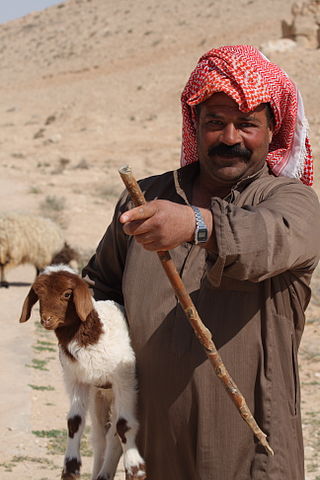
Bedouin shepherd in the Syrian desert
While most modern Bedouins have abandoned their nomadic and tribal traditions for modern urban lifestyles, they retain traditional Bedouin culture with traditional music, poetry, dances, and other cultural practices.
The Bedouin tribes in pre-Islamic Arabia were nomadic-pastoralists. Pastoralists depend on their small herds of goats, sheep, camels, horses, or other animals for meat, milk, cheese, blood, fur/wool, and other sustenance. Because of the harsh climate and the seasonal migrations required to obtain resources, the Bedouin nomadic tribes generally raised sheep, goats, and camels. Each member of the family had a specific role in taking care of the animals, from guarding the herd to making cheese from milk. The nomads also hunted, served as bodyguards, escorted caravans, and worked as mercenaries. Some tribes traded with towns in order to gain goods, while others raided other tribes for animals, women, gold, fabric, and other luxury items.
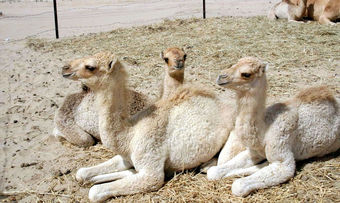
Bedouin tribes raised camels as part of their nomadic-pastoralist lifestyle
Tribes migrated seasonally to reach resources for their herds of sheep, goats, and camels. Each member of the family had a specific role in taking care of the animals, from guarding the herd to making cheese from milk.
Origin of Jewish and Other Tribes
The first mention of Jews in the areas of modern-day Saudi Arabia dates back, by some accounts, to the time of the First Temple. Immigration to the Arabian Peninsula began in earnest in the 2nd century CE, and by the 6th and 7th centuries there was a considerable Jewish population in Hejaz, mostly in and around Medina. This was partly because of the embrace of Judaism by leaders such as Abu Karib Asad and Dhu Nuwas, who was very aggressive about converting his subjects to Judaism, and who persecuted Christians in his kingdom as a reaction to Christian persecution of Jews there by the local Christians. Before the rise of Islam, there were three main Jewish tribes in the city of Medina: the Banu Nadir, the Banu Qainuqa, and the Banu Qurayza. Arab tribes, most notably the Ghassanids and Lakhmids, began to appear in the south Syrian deserts and southern Jordan from the mid 3rd century CE, during the mid to later stages of the Roman Empire and Sassanid Empire. The Nabatean civilization in Jordan was an Aramaic-speaking ethnic mix of Canaanites, Arameans, and Arabs. According to tradition, the Saudi Bedouin are descendants of two groups. One group, the Yemenis, settled in southwestern Arabia, in the mountains of Yemen, and claimed they descended from a semi-legendary ancestral figure, Qahtan (or Joktan). The second group, the Qaysis, settled in north-central Arabia and claimed they were descendants of the Biblical Ishmael.
10.1.2: Arabian Cities
Cities like Mecca and Medina acted as important centers of trade and religion in pre-Islamic Arabia.
Learning Objective
Examine the historical significance of Mecca and Medina
Key Points
- As sea trade routes became more dangerous, several tribes built the Arabian city of Mecca into a center of trade to direct more secure overland caravan routes.
- Once a year, the nomadic tribes would declare a truce and converge upon Mecca in a pilgrimage to pay homage to their idols at the Kaaba and drink from the Zamzam Well.
- The oasis city of Yathrib, also known as Medina, was ruled by several Jewish tribes until Arab tribes gained political power around 400 CE.
Key Terms
- Ishmael
-
A figure in the Hebrew Bible and the Qur’an, and Abraham’s first son according to Jews, Christians, and Muslims. He was born of Abraham’s marriage to Sarah’s handmaiden Hagar.
- Kaaba
-
A sacred building in the city of Mecca that housed the tribal idols until the rise of Islam in 7th century, when it became the center of Islam’s most sacred mosque.
- Zamzam Well
-
A well located in the city of Mecca that, according to Islamic belief, is a miraculously generated source of water from God.
Although the majority of pre-Islamic Arabia was nomadic, there were several important cities that came into being as centers of trade and religion, such as Mecca, Medina (Yathrib), Karbala, and Damascus. The most important of these cities was Mecca, which was an important center of trade in the area, as well as the location of the Kaaba (or Ka’ba), one of the most revered shrines in polytheistic Arabia. After the rise of Islam, the Kaaba became the most sacred place in Islam.
Islamic tradition attributes the beginning of Mecca to Ishmael’s descendants. Many Muslims point to the Old Testament chapter Psalm 84:3–6 and a mention of a pilgrimage at the Valley of Baca, which is interpreted as a reference to Mecca as Bakkah in Qur’an Surah 3:96. The Greek historian Diodorus Siculus, who lived between 60 BCE and 30 BCE, wrote about the isolated region of Arabia in his work Bibliotheca historica, describing a holy shrine that Muslims see as Kaaba at Mecca: “And a temple has been set up there, which is very holy and exceedingly revered by all Arabians.” Some time in the 5th century, the Kaaba was a place to worship the deities of Arabia’s pagan tribes. Mecca’s most important pagan deity was Hubal, whose idol had been placed there by the ruling Quraysh tribe and remained until the 7th century.
The City of Mecca
In the 5th century, the Quraysh tribes took control of Mecca and became skilled merchants and traders. In the 6th century, they joined the lucrative spice trade, since battles in other parts of the world were causing traders to divert from the dangerous sea routes to the more secure overland routes. The Byzantine Empire had previously controlled the Red Sea, but piracy had been increasing. Another previous route, which ran through the Persian Gulf via the Tigris and Euphrates rivers, was also threatened by exploitations from the Sassanid Empire, and disrupted by the Lakhmids, the Ghassanids, and the Roman–Persian Wars.
Mecca’s prominence as a trading center eventually surpassed the cities of Petra and Palmyra. Historical accounts also provide some indication that goods from other continents may also have flowed through Mecca. Camel caravans, said to have first been used by Muhammad’s great-grandfather, were a major part of Mecca’s bustling economy. Alliances were struck between the merchants in Mecca and the local nomadic tribes, who would bring goods—leather, livestock, and metals mined in the local mountains—to Mecca to be loaded on the caravans and carried to cities in Syria and Iraq. Historical accounts provide some indication that goods from other continents may also have flowed through Mecca. Goods from Africa and the Far East passed through en route to Syria. The Meccans signed treaties with both the Byzantines and the Bedouins to negotiate safe passages for caravans and give them water and pasture rights. Mecca became the center of a loose confederation of client tribes, which included those of the Banu Tamim. Other regional powers such as the Abyssinian, Ghassan, and Lakhm were in decline, leaving Meccan trade to be the primary binding force in Arabia in the late 6th century.
The harsh conditions and terrain of the Arabian peninsula meant a near-constant state of conflict between the local tribes, but once a year they would declare a truce and converge upon Mecca in a pilgrimage. Up to the 7th century, this journey was undertaken by the pagan Arabs to pay homage to their shrine and drink from the Zamzam Well. However, it was also the time each year when disputes would be arbitrated, debts would be resolved, and trading would occur at Meccan fairs. These annual events gave the tribes a sense of common identity and made Mecca an important focus for the peninsula.
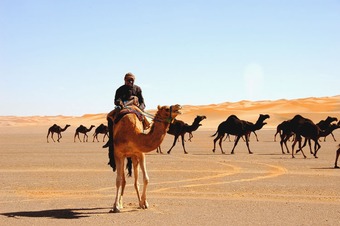
A modern-day caravan crossing the Arabian Peninsula
As sea trade routes became more dangerous, several tribes built the Arabian city of Mecca into a center of trade to direct more secure overland caravan routes.
The City of Medina (Yathrib)
Although the city of Medina did not have any great distinction until the introduction of Islam, it has always held an important place in trade and agriculture because of its location in a fertile region of the Hejaz. The city was able to maintain decent amounts of food and water, and therefore was an important pit stop for trade caravans traveling along the Red Sea. This was especially important given the merchant culture of Arabia. Along with the port of Jidda, Medina and Mecca thrived through years of pilgrimage.
During the pre-Islamic period up until 622 CE, Medina was known as Yathrib, an oasis city. Yathrib was dominated by Jewish tribes until around 400 CE, when several Arab tribes gained political power. Medina is celebrated for containing the mosque of Muhammad. Medina is 210 miles (340 km) north of Mecca and about 120 miles (190 km) from the Red Sea coast. It is situated in the most fertile part of the Hejaz territory, where the streams of the vicinity converge. An immense plain extends to the south; in every direction the view is bounded by hills and mountains.
In 622 CE, Muhammad and around 70 Meccan Muhajirun believers left Mecca for sanctuary in Yathrib, an event that transformed the religious and political landscape of the city completely. The longstanding enmity between the Aus and Khazraj tribes was dampened as many tribe members, and some local Jews, embraced Islam. Muhammad, linked to the Khazraj through his great-grandmother, was agreed on as civic leader.
The Muslim converts native to Yathrib—whether pagan Arab or Jewish—were called Ansar (“the Patrons” or “the Helpers”). According to Ibn Ishaq, the local pagan Arab tribes, the Muslim Muhajirun from Mecca, the local Muslims (Ansar), and the Jews of the area signed an agreement, the Constitution of Medina, which committed all parties to mutual cooperation under the leadership of Muhammad. The nature of this document as recorded by Ibn Ishaq and transmitted by Ibn Hisham is the subject of dispute among modern Western historians. Many maintain that this “treaty” is possibly a collage of different agreements, oral rather than written, of different dates, and that it is not clear when they were made. Other scholars, however, both Western and Muslim, argue that the text of the agreement—whether it was originally a single document or several—is possibly one of the oldest Islamic texts we possess.
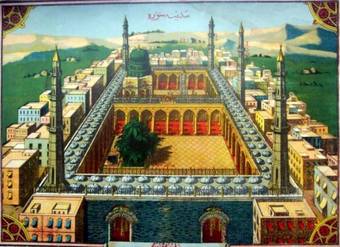
Medina
Old depiction of Medina during Ottoman times.
10.1.3: Culture and Religion in Pre-Islamic Arabia
The nomadic tribes of pre-Islamic Arabia primarily practiced polytheism, although some tribes converted to Judaism and Christianity.
Learning Objective
Explain the significance of polytheism and monotheism in pre-Islamic Arabia
Key Points
- Before the rise of the monotheistic religions of Judaism, Christianity, and Islam, most Bedouin tribes practiced polytheism in the form of animism and idolatry.
- Three of the ruling tribes of Yathrib (Medina) were Jewish, one of the oldest monotheistic religions.
- Christianity spread to Arabia after Constantinople conquered Byzantium in 324 CE, and it was adopted by several Bedouin tribes.
- Poetry was a large part of tribal culture and communication, and it was often used as propaganda against other tribes.
Key Terms
- monotheism
-
The belief in the existence of a single god.
- idolatry
-
The worship of an idol or a physical object, such as a cult image, as a god.
- animism
-
The worldview that non-human entities (animals, plants, and inanimate objects or phenomena) possess a spiritual essence; often practiced by tribal groups before organized religion.
- Ka’aba
-
A building at the center of Islam’s most sacred mosque, Al-Masjid al-Haram, in Mecca, al-Hejaz, Saudi Arabia. It is the most sacred Muslim site in the world.
- polytheism
-
The worship of or belief in multiple deities usually assembled into a pantheon of gods and goddesses, along with their own religions and rituals.
Overview
Religion in pre-Islamic Arabia was a mix of polytheism, Christianity, Judaism, and Iranian religions. Arab polytheism, the dominant belief system, was based on the belief in deities and other supernatural beings such as djinn. Gods and goddesses were worshipped at local shrines, such as the Kaaba in Mecca. Some scholars postulate that Allah may have been one of the gods of the Meccan religion to whom the shrine was dedicated, although it seems he had little relevance in the religion. Many of the physical descriptions of the pre-Islamic gods are traced to idols, especially near the Kaaba, which is believed to have contained up to 360 of them.
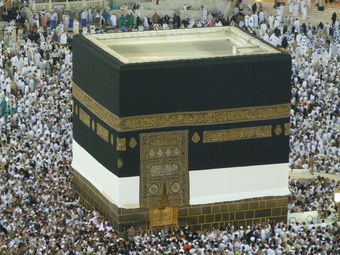
The Kaaba
The Kaaba is a cube-shaped building in Mecca held to be sacred both by Muslims and pre-Islamic polytheistic tribes.
Other religions were represented to varying, lesser degrees. The influence of the adjacent Roman, Axumite, and Sasanian empires resulted in Christian communities in the northwest, northeast, and south of Arabia. Christianity made a lesser impact, but secured some conversions in the remainder of the peninsula. With the exception of Nestorianism in the northeast and the Persian Gulf, the dominant form of Christianity was Monophysitism. The Arabian peninsula had been subject to Jewish migration since Roman times, which had resulted in a diaspora community supplemented by local converts. Additionally, the influence of the Sasanian Empire resulted in the presence Iranian religions. Zoroastrianism existed in the east and south, and there is evidence of Manichaeism or possibly Mazdakism being practiced in Mecca.
Polytheism in Pre-Islamic Arabia
Before the rise of Islam, most Bedouin tribes practiced polytheism, most often in the form of animism. Animists believe that non-human entities (animals, plants, and inanimate objects or phenomena) possess a spiritual essence. Totemism and idolatry, or worship of totems or idols representing natural phenomena, were also common religious practices in the pre-Islamic world. Idols were housed in the Kaaba, an ancient sanctuary in the city of Mecca. The site housed about 360 idols and attracted worshippers from all over Arabia. According to the holy Muslim text the Quran, Ibrahim, together with his son Ishmael, raised the foundations of a house and began work on the Kaaba around 2130 BCE.
The chief god in pre-Islamic Arabia was Hubal, the Syrian god of the moon. The three daughters of Hubal were the chief goddesses of Meccan Arabian mythology: Allāt, Al-‘Uzzá, and Manāt. Allāt was the goddess associated with the underworld. Al-‘Uzzá, “The Mightiest One” or “The Strong,” was a fertility goddess, and she was called upon for protection and victory before war. Manāt was the goddess of fate; the Book of Idols describes her as the most ancient of all these idols. The Book of Idols describes gods and rites of Arabian religion, but criticizes the idolatry of pre-Islamic religion.
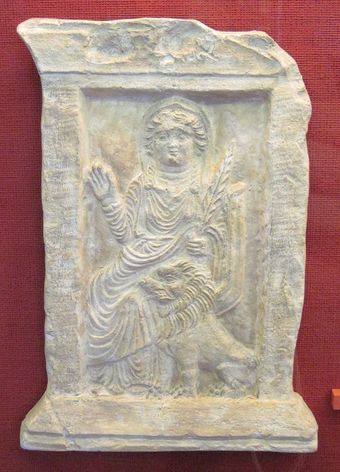
Relief of the goddess Allāt, one of the three patron gods of the city of Mecca
Before the rise of the monotheistic religions of Judaism, Christianity, and Islam, most Bedouin tribes practiced polytheism in the form of animism and idolatry.
Monotheism in Pre-Islamic Arabia
Judaism
The most well-known monotheists were the Hebrews, although the Persians and the Medes had also developed monotheism. Judaism is one of the oldest monotheistic religions.
A thriving community of Jewish tribes existed in pre-Islamic Arabia and included both sedentary and nomadic communities. Jews migrated into Arabia starting Roman times. Arabian Jews spoke Arabic as well as Hebrew and Aramaic and had contact with Jewish religious centers in Babylonia and Palestine. The Yemeni Himyarites converted to Judaism in the 4th century, and some of the Kindah, a tribe in central Arabia who were the Himyarites’ vassals, were also converted in the 4th/5th century. There is evidence that Jewish converts in the Hejaz were regarded as Jews by other Jews and non-Jews alike, and sought advice from Babylonian rabbis on matters of attire and kosher food. In at least one case, it is known that an Arab tribe agreed to adopt Judaism as a condition for settling in a town dominated by Jewish inhabitants. Some Arab women in Yathrib/Medina are said to have vowed to make their child a Jew if the child survived, since they considered the Jews to be people “of knowledge and the book.” Historian Philip Hitti infers from proper names and agricultural vocabulary that the Jewish tribes of Yathrib consisted mostly of Judaized clans of Arabian and Aramaean origin.
Christianity
After Constantine conquered Byzantium in 324 CE, Christianity spread to Arabia. The principal tribes that embraced Christianity were the Himyar, Ghassan, Rabi’a, Tagh’ab, Bahra, and Tunukh, parts of the Tay and Khud’a, the inhabitants of Najran, and the Arabs of Hira. Traditionally, both Jews and Christians believe in the God of Abraham, Isaac and Jacob, for Jews the God of the Tanakh, for Christians the God of the Old Testament, the creator of the universe. Both religions reject the view that God is entirely transcendent, and thus separate from the world, as the pre-Christian Greek Unknown God. Both religions also reject atheism on one hand and polytheism on the other.
The main areas of Christian influence in Arabia were on the northeastern and northwestern borders and in what was to become Yemen in the south. The northwest was under the influence of Christian missionary activity from the Roman Empire, where the Ghassanids, residents of a client kingdom of the Romans, were converted to Christianity. In the south, particularly at Najran, a center of Christianity developed as a result of the influence of the Christian kingdom of Axum based on the other side of the Red Sea in Ethiopia. Both the Ghassanids and the Christians in the south adopted Monophysitism. The spread of Christianity was halted in 622 CE by the rise of Islam, though the city of Mecca provided a central location for an intermingling of the two cultures. For example, in addition to the animistic idols, the pre-Islamic Kaaba housed statues of Jesus and his holy mother, Mary.
Nomadic Culture and Poetry
Like later cultures in the region, the Bedouin tribes placed heavy importance on poetry and oral tradition as a means of communication. Poetry was used to communicate within the community and sometimes promoted tribal propaganda. Tribes constructed verses against their enemies, often discrediting their people or fighting abilities. Poets maintained sacred places in their tribes and communities because they were thought to be divinely inspirited. Poets often wrote in classical Arabic, which differed from the common tribal dialect. Poetry was also a form of entertainment, as many poets constructed prose about the nature and beauty surrounding their nomadic lives.
Music
Arabian music extended from the Islamic peoples in Arabia to North Africa, Persia, and Syria. Although the major writings on Arabian music appeared after the dawn of Islam (622 CE), music had already been cultivated for thousands of years. Pre-Islamic Arabian music was primarily vocal, and it may have developed from simple caravan songs (huda) to a more sophisticated secular song (nasb). Instruments were generally used alone and served only to accompany the singer. The short lute (‘ud), long lute (tunbur), flute (qussaba), tambourine (duff), and drum (tabl) were the most popular instruments.
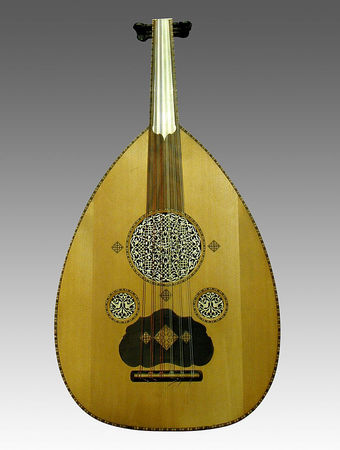
An ‘ud
The ‘ud was one of the instruments used to accompany singers. Pre-Islamic and post-Islamic music was important for poetry and oral traditions.
10.1.4: Women in Pre-Islamic Arabia
Women had almost no legal status under tribal law in pre-Islamic Arabia.
Learning Objective
Assess the role and rights of women in Islamic and pre-Islamic Arabia
Key Points
- In the nomadic Bedouin tribes, tribal law determined women’s rights, while in the Christian and Jewish southern Arabian Peninsula, Christian and Hebrew edicts determined women’s rights.
- Under the customary tribal law existing in Arabia before the rise of Islam, women, as a general rule, had virtually no legal status; fathers sold their daughters into marriage for a price, the husband could terminate the union at will, and women had little or no property or succession rights.
- One of the most important roles for women was to produce children, especially male offspring; women also cooked meals, milked animals, washed clothes, prepared butter and cheese, spun wool, and wove fabric for tents.
- Upper-class women usually had more rights than tribal women and might own property or even inherit from relatives.
- In many modern-day Islamic countries, politics and religion are linked by Sharia law, including the mandatory wearing of the hijab in countries like Saudi Arabia.
Key Terms
- Jahiliyyah
-
The period of ignorance before the rise of Islam.
- hijab
-
A veil that covers the head and chest, which is particularly worn by some Muslim women in the presence of adult males outside of their immediate family.
- Sharia
-
(Islamic law) deals with many topics addressed by secular law, including crime, politics, and economics, as well as personal matters such as sexual intercourse, hygiene, diet, prayer, everyday etiquette and fasting. Historically, adherence to Islamic law has served as one of the distinguishing characteristics of the Muslim faith.
In pre-Islamic Arabia, women’s status varied widely according to the laws and cultural norms of the tribes in which they lived. In the prosperous southern region of the Arabian Peninsula, for example, the religious edicts of Christianity and Judaism held sway among the Sabians and Himyarites. In other places, such as the city of Mecca, and in the nomadic Bedouin tribes, tribal law determined women’s rights. Therefore, there was no single definition of the roles played and rights held by women prior to the advent of Islam.
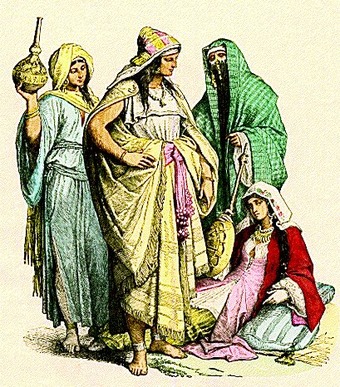
Depiction of the costumes of women in the 4th-6th centuries
Under the customary tribal law existing in Arabia before the rise of Islam, as a general rule women had virtually no legal status; fathers sold their daughters into marriage for a price, the husband could terminate the union at will, and women had little or no property or succession rights.
Tribal Law
Under the customary tribal law existing in Arabia at the advent of Islam, as a general rule women had virtually no legal status. The tribe acted as the main functional unit of Arabian society and was composed of people with connections to a common relative. These tribes were patriarchal and inheritance was passed through the male lines; women could not inherit property. The tribal leader enforced the tribe’s spoken rules, which generally limited the rights of the women. Women were often considered property to be inherited or seized in a tribal conflict.
There were also patterns of homicidal abuse of women and girls, including instances of killing female infants if they were considered a liability. The Quran mentions that the Arabs in Jahiliyyah (the period of ignorance or pre-Islamic period) used to bury their daughters alive. The motives were twofold: the fear that an increase in female offspring would result in economic burden, and the fear of the humiliation frequently caused when girls were captured by a hostile tribe and subsequently preferring their captors to their parents and brothers.
Women in Islam and the Hijab
After the rise of Islam, the Quran (the word of God) and the Hadith (the traditions of the prophet Muhammad) developed into Sharia, or Islamic religious law. Sharia dictates that women should cover themselves with a veil. Women who follow these traditions feel it wearing the hijab is their claim to respectability and piety. One of the relevant passages from the Quran translates as “O Prophet! Tell thy wives and daughters, and the believing women, that they should cast their outer garments over their persons, that are most convenient, that they should be known and not molested. And Allah is Oft-Forgiving, Most Merciful” (Quran Surat Al-Ahzab 33:59). These areas of the body are known as “awrah” (parts of the body that should be covered) and are referred to in both the Quran and the Hadith. “Hijab” can also be used to refer to the seclusion of women from men in the public sphere.
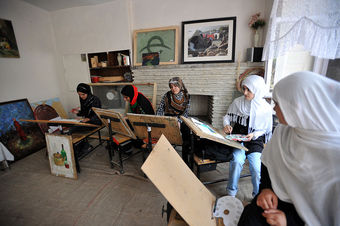
Modern-day female art students in Afghanistan
In many modern Islamic countries, Sharia combines politics and religion. For example, in Saudi Arabia it is mandatory for women to wear the hijab, while in Afghanistan it is very common but not legally required by the state.
The practice of women covering themselves with veils was also known during pre-Islamic times. In the Byzantine Empire and pre-Islamic Persia, a veil was a symbol of respect worn by the elite and upper-class women.
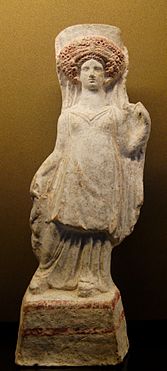
Standing woman holding her veil. Terracotta figurine, c. 400–375 BC
Veils were present in the Byzantine Empire and pre-Islamic Persia, and veil wearing is now a basic principle of the Islamic faith.
Marriage
In pre-Islamic Arabian culture, women had little control over their marriages and were rarely allowed to divorce their husbands. Marriages usually consisted of an agreement between a man and his future wife’s family, and occurred either within the tribe or between two families of different tribes. As part of the agreement, the man’s family might offer property such as camels or horses in exchange for the woman. Upon marriage, the woman would leave her family and reside permanently in the tribe of her husband. Marriage by capture, or “Ba’al,” was also a common pre-Islamic practice.
Under Islam, polygyny (the marriage of multiple women to one man) is allowed, but not widespread. In some Islamic countries, such as Iran, a woman’s husband may enter into temporary marriages in addition to permanent marriage. Islam forbids Muslim women from marrying non-Muslims.
Family Structure
One of the most important roles for women in pre-Islamic tribes was to produce children, especially male offspring. A woman’s male children could inherit property and increased the wealth of the tribe. While men often tended the herds of livestock and guarded the tribe, women played integral roles within tribal society. Women cooked meals, milked animals, washed clothes, prepared butter and cheese, spun wool, and wove fabric for tents.
Upper-Class Women
While the general population of women in pre-Islamic Arabia did not enjoy the luxury of many rights, many women of upper-class status did. They married into comfortable homes and were sometimes able to own property or even inherit from relatives.
10.2: Muhammad and the Rise of Islam
10.2.1: Early Life of Muhammad
Born c. 570 CE in Mecca, Muhammad was raised by his uncle Abu Talib and later worked as a merchant.
Learning Objective
Describe Muhammad’s life before 622 CE
Key Points
- Muhammad was born in or around the year 570 CE to the Banu Hashim clan of the Quraysh tribe, one of Mecca’s prominent families.
- Muhammad was orphaned at an early age and brought up under the care of his paternal uncle Abu Talib.
- Muhammad worked mostly as a merchant, as well as a shepherd, and married Khadijah, a 40-year-old widow, in 595 CE when he was twenty-five.
- In 605 CE, Muhammad honored all the Meccan clan leaders and set the Black Stone back into the correct spot in the Ka’aba.
Key Terms
- Quraysh tribe
-
A powerful merchant group that controlled Mecca and the Kaaba.
- the Black Stone
-
The eastern cornerstone of the Kaaba, the ancient stone building located in the center of the Grand Mosque in Mecca, Saudi Arabia. It is revered by Muslims as an Islamic relic that, according to Muslim tradition, dates back to the time of Adam and Eve.
Overview
Muhammad unified Arabia into a single religious polity under Islam. Muslims and Bahá’ís believe he is a messenger and prophet of God. The Quran, the central religious text in Islam, alludes to Muhammad’s life. Muhammad’s life is traditionally defined into two periods: pre-hijra (emigration) in Mecca (from 570 to 622 CE) and post-hijra in Medina (from 622 until 632 CE). There are also traditional Muslim biographies of Muhammad (the sira literature), which provide additional information about Muhammad’s life. Muhammad is almost universally considered by Muslims as the last prophet sent by God to mankind. While non-Muslims regard Muhammad as the founder of Islam, Muslims consider him to have restored the unaltered original monotheistic faith of Adam, Noah, Abraham, Moses, Jesus, and other prophets.
Childhood
Muhammad was born around the year 570 CE to the Banu Hashim clan of the Quraysh tribe, one of Mecca’s prominent families. His father, Abdullah, died almost six months before Muhammad was born. According to Islamic tradition, Muhammad was sent to live with a Bedouin family in the desert, as desert life was considered healthier for infants. Muhammad stayed with his foster mother, Halimah bint Abi Dhuayb, and her husband until he was two years old. At the age of six, Muhammad lost his biological mother, Amina, to illness and was raised by his paternal grandfather, Abd al-Muttalib, until he died when Muhammad was eight. He then came under the care of his uncle Abu Talib, the new leader of Banu Hashim.
Adolescence and Early Adulthood
While still in his teens, Muhammad accompanied his uncle on trading journeys to Syria, gaining experience in commercial trade, which was the only career open to him as an orphan. Islamic tradition states that when Muhammad was either nine or twelve, while accompanying a caravan to Syria he met a Christian monk or hermit named Bahira, who is said to have foreseen Muhammed’s career as a prophet of God. Little is known of Muhammad during his later youth; available information is fragmented, and it is difficult to separate history from legend. It is known that he became a merchant and “was involved in trade between the Indian ocean and the Mediterranean Sea.” Due to his upright character during this time, he acquired the nickname “al-Amin,” meaning “faithful, trustworthy,” and “al-Sadiq,” meaning “truthful.”
Muhammad worked as a trader for Khadija, a widow, until he married her in 595 CE at the age of 25. The marriage lasted for 25 years and was reported to be a happy one. Muhammad relied upon Khadija and did not enter into a marriage with another woman during his first marriage. After Khadija’s death, Khawla bint Hakim suggested that Muhammad that should marry Sawda bint Zama, a Muslim widow, or Aisha, daughter of Um Ruman and Abu Bakr of Mecca. Muhammad is said to have asked for arrangements to marry both.
According to a text collected by historian Ibn Ishaq, Muhammad was involved with a well-known story about setting the Black Stone in place in the wall of the Kaaba in 605 CE. The Black Stone, a sacred object, had been removed to facilitate renovations to the Kaaba. The leaders of Mecca could not agree on which clan should have the honor of setting the Black Stone back in its place. They agreed to wait for the next man to come through the gate and ask him to choose. That man was the 35-year-old Muhammad, five years before his first revelation. He asked for a cloth and put the Black Stone in its center. The clan leaders held the corners of the cloth and together carried the Black Stone to the right spot; then Muhammad set the stone in place, satisfying all who were present.
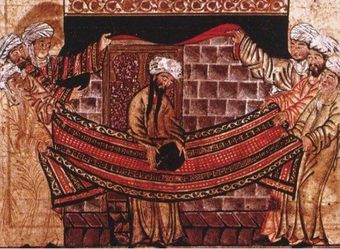
Muhammad and the Black Stone
An illustration from c. 1315 depicting Muhammad’s role in re-setting the Black Stone in 605 CE.
Occasionally he would retreat to a cave in the mountains for several nights of seclusion and prayer; it is reported that it was at this spot that he was visited by Gabriel and received his first revelation from God.
10.2.2: The Quran
Muhammad received revelations from 609-632 CE, and they became the basis for the Quran, the central religious text of Islam.
Learning Objective
Discuss the origins of the first Muslim converts
Key Points
- Muhammad first received revelations in 609 CE in a cave on Mount Hira, near Mecca.
- Muslims regard the Quran as the most important miracle of Muhammad, the proof of his prophethood, and the culmination of a series of divine messages revealed by the angel Gabriel from 609–632 CE.
- The key themes of the early Quranic verses included the responsibility of man towards his creator; the resurrection of the dead, God’s final judgment followed by vivid descriptions of the tortures in Hell and pleasures in Paradise; and the signs of God in all aspects of life. Religious duties included belief in God, asking for forgiveness of sins, offering frequent prayers, assisting others particularly those in need, rejecting cheating and the love of wealth, being chaste, and not killing newborn girls.
- Muhammad’s immediate family were the first to believe he was a prophet, followed by three main groups of early converts to Islam: younger brothers and sons of great merchants, people who had fallen out of the first rank in their tribe or failed to attain it, and unprotected foreigners.
- Muslims believe the Quran to be both the unaltered and the final revelation of God. Religious concepts and practices include the five pillars of Islam, which are obligatory acts of worship, and following Islamic law, which touches on virtually every aspect of life and society, from banking and welfare to the status of women and the environment.
Key Terms
- Quran
-
Literally meaning “the recitation,” it is the central religious text of Islam, which Muslims believe to be a revelation from God.
- Five Pillars of Islam
-
Five basic acts in Islam, considered mandatory by believers and are the foundation of Muslim life.
- Khadijah
-
The first wife of Muhammad.
Muhammad’s First Revelations
When he was nearly 40, Muhammad began spending many hours alone in prayer and speculating over the aspects of creation. He was concerned with the “ignorance of divine guidance” (Jahiliyyah), social unrest, injustice, widespread discrimination (particularly against women), fighting among tribes, and abuse of tribal authorities prevalent in pre-Islamic Arabia. The moral degeneration of his fellow people, and his own quest for a true religion, further lent fuel to this, with the result that he began to withdraw periodically to a cave called Mount Hira, three miles north of Mecca, for contemplation and reflection. During this period Muhammad began to have dreams replete with spiritual significance that were fulfilled according to their true import; this was the commencement of his divine revelation. Islamic tradition holds that during one of his visits to Mount Hira in the year 609 CE, the angel Gabriel appeared to him and commanded Muhammad to recite verses that would later be included in the Quran. Upon receiving his first revelations, Muhammad was deeply distressed. When he returned home, he was consoled and reassured by Khadijah and her Christian cousin. Muhammad feared that others would dismiss his claims as evidence of him being possessed. On the other hand, Shi’a tradition maintains that Muhammad was neither surprised nor frightened at the appearance of Gabriel, but rather welcomed him as if he was expected.
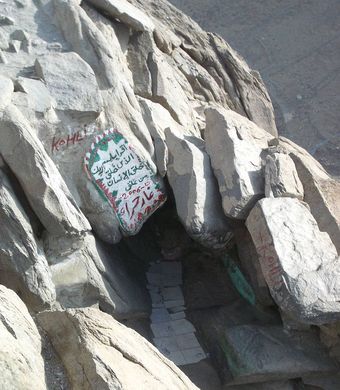
The cave Hira
The cave Hira in the mountain Jabal al-Nour where, according to Muslim belief, Muhammad received his first revelation from the angel Gabriel.
The initial revelation was followed by a pause of three years (a period known as fatra) during which Muhammad felt depressed and further gave himself to prayers and spiritual practices. When the revelations resumed, he was reassured and began preaching.
The Quran
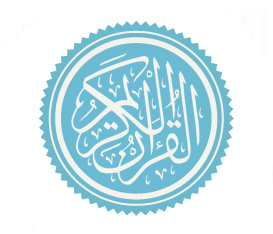
Quran Al-Qurʾn ا
Arabic calligraphy for “Quran”
Muslims believe that the Quran was verbally revealed from God to Muhammad through the angel Gabriel gradually over a period of approximately 23 years, beginning on 22 December 609 CE, when Muhammad was 40, and concluding in 632 CE, the year of his death. At the beginning of these revelations, Muhammad was confident that he could distinguish his own thoughts from the messages. Sahih al-Bukhari narrates Muhammad describing the revelations as, “Sometimes it is (revealed) like the ringing of a bell,” and Aisha reported, “I saw the Prophet being inspired Divinely on a very cold day and noticed the sweat dropping from his forehead (as the Inspiration was over).”
Muhammad’s first revelation, according to the Quran, was accompanied by a vision. The agent of revelation is mentioned as the “one mighty in power,” the one who “grew clear to view when he was on the uppermost horizon. Then he drew nigh and came down till he was (distant) two bows’ length or even nearer.” The Islamic studies scholar Welch states in the Encyclopaedia of Islam that he believes the graphic descriptions of Muhammad’s condition at these moments may be regarded as genuine, because he was severely disturbed after these revelations. According to Welch, these seizures would have been seen by those around him as evidence for the superhuman origin of Muhammad’s inspirations. However, Muhammad’s critics accused him of being a possessed man, a soothsayer or a magician, since his experiences were similar to those claimed by such figures well known in ancient Arabia. Welch additionally states that it remains uncertain whether these experiences occurred before or after Muhammad’s initial claim of prophethood.
The Quran describes Muhammad as “ummi,” which is traditionally interpreted as “illiterate,” but the meaning is more complex. Medieval commentators such as Al-Tabari maintained that the term induced two meanings: firstly, the inability to read or write in general, and secondly, the inexperience or ignorance of books or scriptures. However, priority was given to the first meaning. Muhammad’s illiteracy was taken as a sign of the genuineness of his prophethood. For example, according to Fakhr al-Din al-Razi, if Muhammad had mastered writing and reading he possibly would have been suspected of having studied the books of the ancestors. Some scholars such as Watt prefer the second meaning.
According to the Quran, one of the main roles of Muhammad is to warn the unbelievers of their punishment at the end of the world. The Quran does not explicitly refer to Judgment Day, but provided examples from the history of extinct communities and warns Muhammad’s contemporaries of similar calamities. Muhammad did not only warn those who rejected God’s revelation, but also dispensed good news for those who abandoned evil, listening to the divine words and serving God. Muhammad’s mission also involves preaching monotheism; the Quran commands Muhammad to proclaim and praise the name of his Lord and instructs him not to worship idols or associate other deities with God.
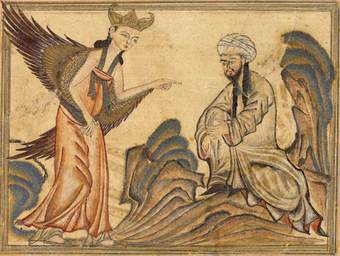
A depiction of Muhammad receiving his first revelation from the angel Gabriel
Muslims regard the Quran as the most important miracle of Muhammad, the proof of his prophethood, and the culmination of a series of divine messages revealed by the angel Gabriel from 609–632 CE. (From the manuscript Jami’ al-tawarikh by Rashid-al-Din Hamadani, 1307, Ilkhanate period)
The key themes of the early Quranic verses included the responsibility of man towards his creator; the resurrection of the dead, God’s final judgment followed by vivid descriptions of the tortures in Hell and pleasures in Paradise; and the signs of God in all aspects of life. Religious duties required of the believers at this time were few: belief in God, asking for forgiveness of sins, offering frequent prayers, assisting others, particularly those in need, rejecting cheating and the love of wealth (considered to be significant in the commercial life of Mecca), being chaste, and not killing newborn girls.
Rise of Islam in Mecca
According to Muslim tradition, Muhammad’s wife Khadija was the first to believe he was a prophet. She was followed by Muhammad’s ten-year-old cousin Ali ibn Abi Talib, close friend Abu Bakr, and adopted son Zaid. Around 613, Muhammad began to preach to the public. Most Meccans ignored and mocked him, but he did begin to gain followers. There were three main groups of early converts to Islam: younger brothers and sons of great merchants; people who had fallen out of the first rank in their tribe or failed to attain it; and the weak, mostly unprotected foreigners.
Basic Tenets and Practices of Islam
Islam is a monotheistic and Abrahamic religion articulated by the Quran, which is considered by its adherents to be the verbatim word of God (Allah), and, for the vast majority of adherents, by the teachings and normative example (called the sunnah, composed of accounts called hadith) of Muhammad. An adherent of Islam is called a Muslim. Muslims believe that God is one and incomparable and that the purpose of existence is to worship God. Nearly all Muslims consider Muhammad to be the last prophet of God.
Muslims also believe that Islam is the complete and universal version of a primordial faith that was revealed many times before through prophets including Adam, Noah, Abraham, Moses, and Jesus. Muslims believe the Quran to be both the unaltered and the final revelation of God. Religious concepts and practices include the Five Pillars of Islam and following Islamic law, which touches on virtually every aspect of life and society, from banking and welfare to the status of women and the environment.
The Five Pillars of Islam are five basic acts in Islam; they are considered mandatory by believers and are the foundation of Muslim life. They are summarized in the famous hadith of Gabriel. The Five Pillars are:
- Shahada (faith): there is only one God (Allah), and Muhammad is God’s messenger. It is a set statement normally recited in Arabic: lā ʾilāha ʾillā-llāhu muḥammadun rasūlu-llāh (لَا إِلٰهَ إِلَّا الله مُحَمَّدٌ رَسُولُ الله) “There is no god but God (and) Muhammad is the messenger of God.”
- Salat (prayer): consists of five daily prayers, the names referring to the prayer times: Fajr (dawn), Dhuhr (noon), ʿAṣr (afternoon), Maghrib (evening), and ʿIshāʾ (night). All of these prayers are recited while facing in the direction of the Kaaba in Mecca, and are accompanied by a series of set positions including bowing with hands on knees, standing, prostrating, and sitting in a special position.
- Zakāt (charity): the practice of charitable giving based on accumulated wealth. It is the personal responsibility of each Muslim to ease the economic hardship of others and to strive towards eliminating inequality. Zakāt consists of spending a portion of one’s wealth for the benefit of the poor or needy, like debtors or travelers.
- Sawm (fasting): three types of fasting are recognized by the Quran: ritual fasting, fasting as compensation for repentance, and ascetic fasting. Ritual fasting is an obligatory act during the month of Ramadan. The fast is meant to allow Muslims to seek nearness to and look for forgiveness from God, to express their gratitude to and dependence on him, to atone for their past sins, and to remind them of the needy.
- Hajj (pilgrimage to Mecca): every able-bodied Muslim is obliged to make the pilgrimage to Mecca at least once in his or her life. The main rituals of the Hajj include walking seven times around the Kaaba, termed Tawaf; touching the Black Stone, termed Istilam; traveling seven times between Mount Safa and Mount Marwah, termed Sa’yee; and symbolically stoning the Devil in Mina, termed Ramee.
10.2.3: Flight from Mecca to Medina
As Islam faced more political and religious opposition in Mecca, Muhammad and his followers migrated to Medina in 622 CE.
Learning Objective
Explain the basis for opposition to Muhammad
Key Points
- As Islam spread in Mecca, the ruling tribes began to oppose Muhammad’s preaching and his condemnation of idolatry.
- The Quraysh tribe controlled the Kaaba and drew their religious and political power from its polytheistic shrines, so they began to persecute the Muslims and many of Muhammad’s followers became martyrs.
- When Muhammad’s wife Khadijah and uncle Abu Talib both died in 619 CE, Abu Lahab assumed leadership of the Banu Hashim clan and withdrew the clan’s protection from Muhammad.
- In 622 CE, Muhammad and his followers migrated to Yathrib in the Hijra to escape persecution, renaming the city Medina in honor of the prophet.
- Among the first things Muhammad did to ease the longstanding grievances among the tribes of Medina was draft a document known as the Constitution of Medina.
Key Terms
- Banu Hashim clan
-
One of Mecca’s prominent families and part of the Quraysh tribe.
- Mecca
-
The birthplace of Muhammad and the site of Muhammad’s first revelation of the Quran, this city is regarded as the holiest city in the religion of Islam.
- Hijra
-
The migration or journey of the Islamic prophet Muhammad and his followers from Mecca to Medina in June 622 CE.
- Medina
-
Muhammad’s destination during the Hijra, which became the power base of Islam in its first century (renamed from Yathrib).
Muhammad Starts Preaching
During the first three years of his ministry, Muhammad preached Islam privately, mainly among his near relatives and close acquaintances. According to Muslim tradition, Muhammad’s wife Khadija was the first to believe he was a prophet. She was followed by Muhammad’s ten-year-old cousin Ali ibn Abi Talib, close friend Abu Bakr, and adopted son Zaid. According to Islamic belief, in the fourth year of Muhammad’s prophethood, around 613, he was ordered by God to make his propagation of this monotheistic faith public. Muhammad’s earliest teachings were marked by his insistence on the oneness of God, the denunciation of polytheism, belief in the last judgment and its recompense, and social and economic justice.
Most Meccans ignored and mocked him, though a few became his followers. There were three main groups of early converts to Islam: younger brothers and sons of great merchants; people who had fallen out of the first rank in their tribe or failed to attain it; and the weak, mostly unprotected foreigners.
Opposition in Mecca
According to Ibn Sad, one of Muhammad’s companions, the opposition in Mecca started when Muhammad delivered verses that condemned idol worship and polytheism. However, the Quran maintains that it began when Muhammad started public preaching. As Islam spread, Muhammad threatened the local tribes and Meccan rulers because their wealth depended on the Kaaba. Muhammad’s preaching was particularly offensive to his own Quraysh tribe because they guarded the Kaaba and drew their political and religious power from its polytheistic shrines.
The ruling tribes of Mecca perceived Muhammad as a danger that might cause tensions similar to the rivalry of Judaism and Bedouin Polytheism in Yathrib. The powerful merchants in Mecca attempted to convince Muhammad to abandon his preaching by offering him admission into the inner circle of merchants and an advantageous marriage. However, Muhammad turned down both offers.
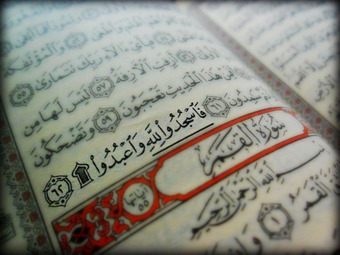
The last ayah from the sura An-Najm in the Quran
Muhammad’s message of monotheism challenged the traditional social order in Mecca. The Quraysh tribe controlled the Kaaba and drew their religious and political power from its polytheistic shrines, so they began to persecute the Muslims and many of Muhammad’s followers became martyrs.
At first, the opposition was confined to ridicule and sarcasm, but later morphed into active persecution that forced a section of new converts to migrate to neighboring Abyssinia (present day Ethiopia). Upset by the rate at which Muhammad was gaining new followers, the Quraysh proposed adopting a common form of worship, which was denounced by the Quran.
Muhammad himself was protected from physical harm as long as he belonged to the Banu Hashim clan, but his followers were not so lucky. Sumayyah bint Khabbab, a slave of the prominent Meccan leader Abu Jahl, is famous as the first martyr of Islam; her master killed her with a spear when she refused to give up her faith. Bilal, another Muslim slave, was tortured by Umayyah ibn Khalaf, who placed more and more rocks on his chest to force his conversion, until he died.
Death of Khadijah and Abu Talib in 619 CE
Muhammad’s wife Khadijah and uncle Abu Talib both died in 619 CE, the year that became known as the “year of sorrow.” With the death of Abu Talib, Abu Lahab assumed leadership of the Banu Hashim clan. Soon after, Abu Lahab withdrew the clan’s protection from Muhammad, endangering him and his followers. Muhammad took this opportunity to look for a new home for himself and his followers. After several unsuccessful negotiations, he found hope with some men from Yathrib (later called Medina). The Arab population of Yathrib were familiar with monotheism and were prepared for the appearance of a prophet because a Jewish community existed there as well. They also hoped, by the means of Muhammad and the new faith, to gain supremacy over Mecca; the Yathrib were jealous of its importance as the place of pilgrimage. Converts to Islam came from nearly all Arab tribes in Medina; by June of the subsequent year, seventy-five Muslims came to Mecca for pilgrimage and to meet Muhammad.
The Delegation from Medina
A delegation from Medina, consisting of the representatives of the twelve important clans of Medina, invited Muhammad as a neutral outsider to serve as the chief arbitrator for the entire community. There was fighting in Yathrib (Medina) mainly involving its Arab and Jewish inhabitants for around a hundred years before 620. The recurring slaughters and disagreements over the resulting claims, especially after the battle of Bu’ath, in which all the clans were involved, made it obvious that the tribal conceptions of blood feud and an eye for an eye were no longer workable unless there was one man with authority to adjudicate in disputed cases. The delegation from Medina pledged themselves and their fellow citizens to accept Muhammad into their community and physically protect him as one of their own.
The Hijra in 622 CE
The Hijra is the migration of Muhammad and his followers from Mecca to Medina, 320 kilometers (200 miles) north, in 622 CE. Muhammad instructed his followers to emigrate to Medina until nearly all of them left Mecca. According to tradition, the Meccans, alarmed at the departure, plotted to assassinate Muhammad. In June 622, when he was warned of the plot, Muhammad slipped out of Mecca with his companion, Abu Bakr.
On the night of his departure, Muhammad’s house was besieged by the appointed men of Quraysh. It is said that when Muhammad emerged from his house, he recited the a verse from the Quran and threw a handful of dust in the direction of the besiegers, which prevented them seeing him. When the Quraysh learned of Muhammad’s escape, they announced a large reward for bringing him back to them, alive or dead, and pursuers scattered in all directions. After eight days’ journey, Muhammad entered the outskirts of Medina, but did not enter the city directly. He stopped at a place called Quba, some miles from the main city, and established a mosque there. After a fourteen-days stay at Quba, Muhammad started for Medina, participating in his first Friday prayer on the way, and upon reaching the city was greeted cordially by its people.
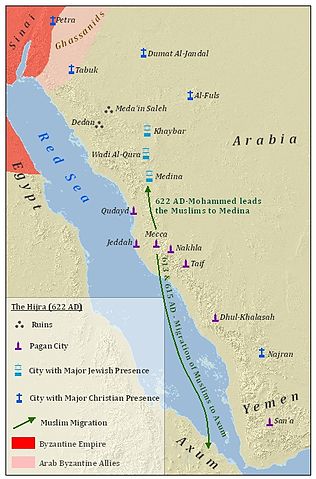
The Hijra and other early Muslim migrations
The Hijra is the migration or journey of the Islamic prophet Muhammad and his followers from Mecca to Yathrib, which he later renamed Medina, in 622 CE.
Muhammad in Medina
Among the first things Muhammad did to ease the longstanding grievances among the tribes of Medina was draft a document known as the Constitution of Medina, “establishing a kind of alliance or federation” among the eight Medinan tribes and Muslim emigrants from Mecca. The document specified rights and duties of all citizens and the relationship of the different communities in Medina (including between the Muslim community and other communities, specifically the Jews and other “Peoples of the Book”). The community defined in the Constitution of Medina, Ummah, had a religious outlook, also shaped by practical considerations, and substantially preserved the legal forms of the old Arab tribes.
The first group of pagan converts to Islam in Medina were the clans who had not produced great leaders for themselves but had suffered from warlike leaders from other clans. This was followed by the general acceptance of Islam by the pagan population of Medina, with some exceptions.
Reconciliation and Consolidation of the Islamic State
Around 628 CE, the nascent Islamic state was somewhat consolidated when Muhammad left Medina to perform pilgrimage at Mecca. The Quraysh intercepted him en route and made a treaty with the Muslims. Though the terms of the Hudaybiyyah treaty may have been unfavorable to the Muslims of Medina, the Quran declared it a clear victory. Muslim historians suggest that the treaty mobilized the contact between the Meccan pagans and the Muslims of Medina. The treaty demonstrated that the Quraysh recognized Muhammad as their equal and Islam as a rising power.
10.2.4: Islam Ascendant
After eight years of warring with Mecca and finally conquering the city in 630 CE, Muhammad united Arabia into a single Islamic state.
Learning Objective
Discuss the rise of Islam under Muhammad
Key Points
- Muhammad created the first Islamic state when he wrote the Constitution of Medina, a formal agreement between Muhammad and all of the significant tribes and families of Medina, including Muslims, Jews, Christians, and pagans.
- The Battle of Badr was a key battle in the early days of Islam and a turning point in Muhammad’s struggle with his opponents among the Quraysh in Mecca.
- The Battle of Uḥud in 625 CE was the second military encounter between the Meccans and the Muslims, but the Muslims suffered defeat and withdrew.
- After eight years of fighting with the Meccan tribes, Muhammad gathered an army of 10,000 followers and conquered the city of Mecca, destroying the pagan idols in the Kaaba.
- By the time of Muhammad’s unexpected death in 632 CE, he had united Arabia into a single Muslim religious polity.
Key Terms
- Ummah
-
The collective community of Islamic peoples.
- Constitution of Medina
-
A formal agreement between Muhammad and all of the significant tribes and families of Medina, including Muslims, Jews, Christians, and pagans, that formed the basis of the first Islamic state.
- Farewell Pilgrimage
-
The only Hajj pilgrimage to Mecca by the Islamic prophet Muhammad, in 632 CE.
The Constitution of Medina
Upon his arrival in Medina, Muhammad unified the tribes by drafting the Constitution of Medina, which was a formal agreement between Muhammad and all of the significant tribes and families of Medina, including Muslims, Jews, Christians, and pagans. This constitution instituted rights and responsibilities and united the different Medina communities into the first Islamic state, the Ummah.
An important feature of the Constitution of Medina is the redefinition of ties between Muslims. It set faith relationships above blood ties and emphasized individual responsibility. Tribal identities were still important, and were used to refer to different groups, but the constitution declared that the “main binding tie” for the newly created Ummah was religion. This contrasts with the norms of pre-Islamic Arabia, which was a thoroughly tribal society. This was an important event in the development of the small group of Muslims in Medina to the larger Muslim community and empire. While praying in the Masjid al-Qiblatain in Medina in 624 CE, Muhammad received revelations that he should be facing Mecca rather than Jerusalem during prayer. Muhammad adjusted to the new direction, and his companions praying with him followed his lead, beginning the tradition of facing Mecca during prayer.
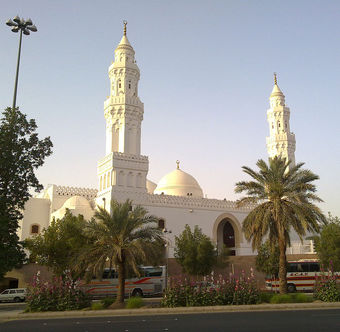
The Masjid al-Qiblatain, where Muhammad established the new Qibla, or direction of prayer
Muhammad received revelations that he should face Mecca, rather than Jerusalem, in 624 CE.
Beginning of Armed Conflict
Economically uprooted by their Meccan persecutors and with no available profession, the Muslim migrants turned to raiding Meccan caravans. This response to persecution and effort to provide sustenance for Muslim families initiated armed conflict between the Muslims and the pagan Quraysh of Mecca. Muhammad delivered Quranic verses permitting the Muslims, “those who have been expelled from their homes,” to fight the Meccans in opposition to persecution. The caravan attacks provoked and pressured Mecca by interfering with trade, and allowed the Muslims to acquire wealth, power, and prestige while working toward their ultimate goal of inducing Mecca’s submission to the new faith.
Battle of Badr
In March 624, Muhammad led three hundred warriors in a raid on a Meccan merchant caravan. The Muslims set an ambush for the caravan at Badr, but a Meccan force intervened and the Battle of Badr commenced. Although outnumbered more than three to one, the Muslims won the battle, killing at least forty-five Meccans. Muhammad and his followers saw the victory as confirmation of their faith, and Muhammad said the victory was assisted by an invisible host of angels. The victory strengthened Muhammad’s position in Medina and dispelled earlier doubts among his followers.
Battle of Uhud
To maintain economic prosperity, the Meccans needed to restore their prestige after their defeat at Badr. Abu Sufyan, the leader of the ruling Quraysh tribe, gathered an army of 3,000 men and set out for an attack on Medina. Muhammad led his Muslim force to the Meccans to fight the Battle of Uhud on March 23, 625 CE. When the battle seemed close to a decisive Muslim victory, the Muslim archers left their assigned posts to raid the Meccan camp. Meccan war veteran Khalid ibn al-Walid led a surprise attack, which killed many Muslims and injured Muhammad. The Muslims withdrew up the slopes of Uḥud. The Meccans did not pursue the Muslims further, but marched back to Mecca declaring victory.
For the Muslims, the battle was a significant setback. According to the Quran, the loss at Uhud was partly a punishment and partly a test for steadfastness.
Conquest of Mecca and Arabia
After eight years of fighting with the Meccan tribes, Muhammad gathered an army of 10,000 Muslim converts and marched on the city of Mecca. The attack went largely uncontested and Muhammad took over the city with little bloodshed. Most Meccans converted to Islam. Muhammad declared an amnesty for past offenses, except for ten men and women who had mocked and made fun of him in songs and verses. Some of these people were later pardoned. Muhammad destroyed the pagan idols in the Kaaba and then sent his followers out to destroy all of the remaining pagan temples in Eastern Arabia.
Following the conquest of Mecca, Muhammad was alarmed by a military threat from the confederate tribes of Hawazin, who were raising an army twice the size of Muhammad’s. The Banu Hawazin were old enemies of the Meccans. They were joined by the Banu Thaqif, who adopted an anti-Meccan policy due to the decline of the prestige of Meccans. Muhammad defeated the Hawazin and Thaqif tribes in the Battle of Hunayn.
At the end of the 10th year after the migration to Medina, Muhammad performed his first truly Islamic pilgrimage, thereby teaching his followers the rules governing the various ceremonies of the annual Great Pilgrimage. In 632, a few months after returning to Medina from the Farewell Pilgrimage, Muhammad fell ill and died. By the time Muhammad died, most of the Arabian Peninsula had converted to Islam, and he had united Arabia into a single Muslim religious polity.
10.3: The Umayyad and Abbasid Empires
10.3.1: Muhammad’s Successors
After Muhammad’s death in 632 CE, there were conflicts among his followers as to who would become his successor, which created a split in Islam between the Sunni and Shi’a sects.
Learning Objective
Assess the Caliphates’ rise to power
Key Points
- After Muhammad’s death in 632 CE, his friend Abu Bakr was named caliph and ruler of the Islamic community, or Ummah.
- Sunni Muslims believe that Abu Bakr was the proper successor, while Shi’a Muslims believe that Ali should have succeed Muhammad as caliph.
- After Muhammad’s death and the rebellion of several tribes, Abu Bakr initiated several military campaigns to bring Arabia under Islam and into the caliphate.
- The Rashidun Caliphate (632–661) was led by Abu Bakr, then by Umar ibn Khattab as the second caliph, Uthman Ibn Affan as the third caliph, and Ali as the fourth caliph.
- Muslim armies conquered most of Arabia by 633, followed by north Africa, Mesopotamia, and Persia, significantly shaping the history of the world through the spread of Islam.
Key Terms
- Sunni
-
The branch of Islam that believes that a caliph should be elected by Muslims or their representatives and that Abu Bakr was the first caliph.
- Ummah
-
An Arabic word meaning “nation” or “community;” usually refers to the collective community of Islamic peoples.
- Shi’a
-
The minority Islamic branch that believes Muhammad appointed his cousin Ali as his successor and that the caliph should be decided based on this family lineage.
- caliph
-
The head of state in a caliphate, and the title for the ruler of the Islamic Ummah; a successor of Muhammad.
Succession after Muhammad’s Death
Muhammad united the tribes of Arabia into a single Arab Muslim religious polity in the last years of his life. He established a new unified Arabian Peninsula, which led to the Rashidun and Umayyad Caliphates and the rapid expansion of Muslim power over the next century.
With Muhammad’s death in 632 CE, disagreement broke out among his followers over deciding his successor. Muhammad’s prominent companion Umar ibn al-Khattab nominated Abu Bakr, Muhammad’s friend and collaborator. With additional support, Abu Bakr was confirmed as the first caliph (religious successor to Muhammad) that same year. This choice was disputed by some of Muhammad’s companions, who held that Ali ibn Abi Talib, his cousin and son-in-law, had been designated the successor by Muhammad at Ghadir Khumm. Ali was Muhammad’s first cousin and closest living male relative, as well as his son-in-law, having married Muhammad’s daughter Fatimah. Ali would eventually become the fourth Sunni caliph. These disagreements over Muhammad’s true successor led to a major split in Islam between what became the Sunni and Shi’a denominations, a division that still holds to this day.
Sunni Muslims believe and confirm that Abu Bakr was chosen by the community and that this was the proper procedure. Sunnis further argue that a caliph should ideally be chosen by election or community consensus. Shi’a Muslims believe that just as God alone appoints a prophet, only God has the prerogative to appoint the successor to his prophet. They believe God chose Ali to be Muhammad’s successor and the first caliph of Islam.
Rise of the Caliphates
After Muhammad’s death, many Arabian tribes rejected Islam or withheld the alms tax established by Muhammad. Many tribes claimed that they had submitted to Muhammad and that with Muhammad’s death, their allegiance had ended. Caliph Abu Bakr insisted that they had not just submitted to a leader, but joined the Islamic community of Ummah.
To retain the cohesion of the Islamic state, Abu Bakr divided his Muslim army to force the Arabian tribes into submission. After a series of successful campaigns, Abu Bakr’s general Khalid ibn Walid defeated a competing prophet and the Arabian peninsula was united under the caliphate in Medina. Once the rebellions had been quelled, Abu Bakr began a war of conquest. In just a few short decades, his campaigns led to one of the largest empires in history. Muslim armies conquered most of Arabia by 633, followed by north Africa, Mesopotamia, and Persia, significantly shaping the history of the world through the spread of Islam.
Rashidun Caliphate (632–661)
Abu Bakr nominated Umar as his successor on his deathbed. Umar ibn Khattab, the second caliph, was killed by a Persian named Piruz Nahavandi. Umar’s successor, Uthman Ibn Affan, was elected by a council of electors (Majlis). Uthman was killed by members of a disaffected group. Ali then took control, but was not universally accepted as caliph by the governors of Egypt, and later by some of his own guard. He faced two major rebellions and was assassinated by Abdl-alRahman, a Kharijite. Ali’s tumultuous rule lasted only five years. This period is known as the Fitna, or the first Islamic civil war.
The followers of Ali later became the Shi’a minority sect of Islam, which rejects the legitimacy of the first three caliphs. The followers of all four Rashidun caliphs (Abu Bakr, Umar, Uthman, and Ali) became the majority Sunni sect. Under the Rashidun, each region (Sultanate) of the caliphate had its own governor (Sultan). Muawiyah, a relative of Uthman and governor (Wali) of Syria, became one of Ali’s challengers, and after Ali’s assassination managed to overcome the other claimants to the caliphate. Muawiyah transformed the caliphate into a hereditary office, thus founding the Umayyad dynasty. In areas that were previously under Sassanid Persian or Byzantine rule, the caliphs lowered taxes, provided greater local autonomy (to their delegated governors), granted greater religious freedom for Jews and some indigenous Christians, and brought peace to peoples demoralized and disaffected by the casualties and heavy taxation that resulted from the decades of Byzantine-Persian warfare.
10.3.2: Expansion Under the Umayyad Caliphates
The Umayyad Caliphate, the second of the four major Arab caliphates established after the death of Muhammad, expanded the territory of the Islamic state to one of the largest empires in history.
Learning Objective
Describe the advancements made under the Umayyad Caliphate
Key Points
- The Umayyad Caliphate, which emerged after the Rashidun Caliphate collapsed, was characterized by hereditary elections and territory expansion.
- The Umayyad Caliphate became one of the largest unitary states in history and one of the few states to ever extend direct rule over three continents.
- When the Abbasid dynasty revolted against the Umayyads and killed many of their ruling family members, a few Umayyads escaped to the Iberian peninsula and founded the Cordoba Caliphate, characterized by peaceful diplomacy, religious tolerance, and cultural flourishing.
Key Terms
- Umayyad Caliphate
-
The second of the four major Arab caliphates established after the death of Muhammad.
- Dome of the Rock
-
A shrine located on the Temple Mount in the Old City of Jerusalem.
- Al-Andalus
-
Also known as Muslim Spain or Islamic Iberia, a medieval Muslim territory and cultural domain occupying at its peak most of modern-day Spain and Portugal.
Umayyad Caliphate (661–750)
The Umayyad Caliphate was the second of the four major Arab caliphates established after the death of Muhammad. This caliphate was centered on the Umayyad dynasty, hailing from Mecca. The Umayyad family had first come to power under the third caliph, Uthman ibn Affan (r. 644–656), but the Umayyad regime was founded by Muawiya ibn Abi Sufyan, long-time governor of Syria, after the end of the First Muslim Civil War in 661 CE. Syria remained the Umayyads’ main power base thereafter, and Damascus was their capital.
Under the Umayyads, the caliphate territory grew rapidly. The Islamic Caliphate became one of the largest unitary states in history, and one of the few states to ever extend direct rule over three continents (Africa, Europe, and Asia). The Umayyads incorporated the Caucasus, Transoxiana, Sindh, the Maghreb, and the Iberian Peninsula (Al-Andalus) into the Muslim world. At its greatest extent, the Umayyad Caliphate covered 5.79 million square miles and included 62 million people (29% of the world’s population), making it the fifth largest empire in history in both area and proportion of the world’s population. Although the Umayyad Caliphate did not rule all of the Sahara, nomadic Berber tribes paid homage to the caliph. However, although these vast areas may have recognized the supremacy of the caliph, de facto power was in the hands of local sultans and emirs.
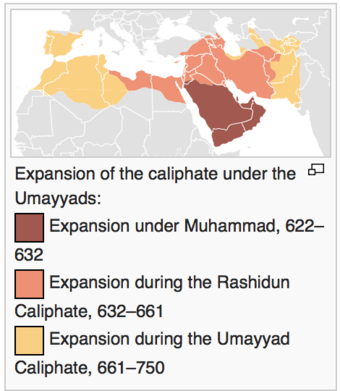
Expansion of the caliphate
This map shows the extension of Islamic rule under Muhammad, the Rashidun Caliphate, and the Umayyad Caliphate.
The Umayyad dynasty was not universally supported within the Muslim community for a variety of reasons, including their hereditary election and suggestions of impious behavior. Some Muslims felt that only members of Muhammad’s Banu Hashim clan or those of his own lineage, such as the descendants of Ali, should rule. Some Muslims thought that Umayyad taxation and administrative practices were unjust. While the non-Muslim population had autonomy, their judicial matters were dealt with in accordance with their own laws and by their own religious heads or their appointees. Non-Muslims paid a poll tax for policing to the central state. Muhammad had stated explicitly during his lifetime that each religious minority should be allowed to practice its own religion and govern itself, and the policy had on the whole continued.
There were numerous rebellions against the Umayyads, as well as splits within the Umayyad ranks, which notably included the rivalry between Yaman and Qays. Allegedly, The Sunnis killed Ali’s son Hussein and his family at the Battle of Karbala in 680, solidifying the Shi’a-Sunni split. Eventually, supporters of the Banu Hashim and the supporters of the lineage of Ali united to bring down the Umayyads in 750. However, the Shiʻat ʻAlī, “the Party of Ali,” were again disappointed when the Abbasid dynasty took power, as the Abbasids were descended from Muhammad’s uncle `Abbas ibn `Abd al-Muttalib, and not from Ali.
The Abbasid victors desecrated the tombs of the Umayyads in Syria, sparing only that of Umar II, and most of the remaining members of the Umayyad family were tracked down and killed. When Abbasids declared amnesty for members of the Umayyad family, eighty gathered to receive pardons, and all were massacred. One grandson of Hisham, Abd al-Rahman I, survived and established a kingdom in Al-Andalus (Moorish Iberia), proclaiming his family to be the Umayyad Caliphate revived.
Umayyad Dynasty in Cordoba, Spain
The revival of the Umayyad Caliphate in Al-Andalus (what would become modern Spain) was called the Caliphate of Córdoba, which lasted until 1031. The period was characterized by an expansion of trade and culture, and saw the construction of masterpieces of al-Andalus architecture.
The caliphate enjoyed increased prosperity during the 10th century. Abd-ar-Rahman III united al-Andalus and brought the Christian kingdoms of the north under control through force and diplomacy. Abd-ar-Rahman stopped the Fatimid advance into caliphate land in Morocco and al-Andalus. This period of prosperity was marked by increasing diplomatic relations with Berber tribes in north Africa, Christian kings from the north, and France, Germany, and Constantinople.
Córdoba was the cultural and intellectual center of al-Andalus. Mosques, such as the Great Mosque, were the focus of many caliphs’ attention. The caliph’s palace, Medina Azahara, was on the outskirts of the city, and had many rooms filled with riches from the East. The library of Al-Ḥakam II was one of the largest libraries in the world, housing at least 400,000 volumes, and Córdoba possessed translations of ancient Greek texts into Arabic, Latin and Hebrew. During the Umayyad Caliphate period, relations between Jews and Arabs were cordial; Jewish stonemasons helped build the columns of the Great Mosque. Al-Andalus was subject to eastern cultural influences as well. The musician Ziryab is credited with bringing hair and clothing styles, toothpaste, and deodorant from Baghdad to the Iberian peninsula. Advances in science, history, geography, philosophy, and language occurred during the Umayyad Caliphate as well.

Mosque
Interior of the Mezquita (Mosque), one of the finest examples of Umayyad architecture in Spain.
Legacy of the Umayyad Caliphate
The Umayyad caliphate was marked both by territorial expansion and by the administrative and cultural problems that such expansion created. Despite some notable exceptions, the Umayyads tended to favor the rights of the old Arab families, and in particular their own, over those of newly converted Muslims (mawali). Therefore, they held to a less universalist conception of Islam than did many of their rivals.
During the period of the Umayyads, Arabic became the administrative language, in which state documents and currency were issued. Mass conversions brought a large influx of Muslims to the caliphate. The Umayyads also constructed famous buildings such as the Dome of the Rock at Jerusalem and the Umayyad Mosque at Damascus.
According to one common view, the Umayyads transformed the caliphate from a religious institution (during the Rashidun) to a dynastic one. However, the Umayyad caliphs do seem to have understood themselves as the representatives of God on Earth.
The Umayyads have met with a largely negative reception from later Islamic historians, who have accused them of promoting a kingship (mulk, a term with connotations of tyranny) instead of a true caliphate (khilafa). In this respect it is notable that the Umayyad caliphs referred to themselves not as khalifat rasul Allah (“successor of the messenger of God,” the title preferred by the tradition), but rather as khalifat Allah (“deputy of God”).
Many Muslims criticized the Umayyads for having too many non-Muslim, former Roman administrators in their government. St. John of Damascus was also a high administrator in the Umayyad administration. As the Muslims took over cities, they left the people’s political representatives and the Roman tax collectors and administrators. The people’s political representatives calculated and negotiated taxes. The central government and the local governments got paid respectively for the services they provided. Many Christian cities used some of the taxes to maintain their churches and run their own organizations. Later, the Umayyads were criticized by some Muslims for not reducing the taxes of the people who converted to Islam.
10.3.3: Spread of Islam
In the years following the Prophet Muhammad’s death, the expansion of Islam was carried out by his successor caliphates, who increased the territory of the Islamic state and sought converts from both polytheistic and monotheistic religions.
Learning Objective
Discuss the spread of Islam and identify how the caliphs maintained authority over conquered territories
Key Points
- The expansion of the Arab Empire in the years following the Prophet Muhammad’s death led to the creation of caliphates, who occupied a vast geographical area and sought converts to Islamic faith.
- The people of the Islamic world created numerous sophisticated centers of culture and science with far-reaching mercantile networks, travelers, scientists, hunters, mathematicians, doctors, and philosophers.
- Historians distinguish between two separate strands of converts of the time. One is animists and polytheists of tribal societies of the Arabian Peninsula and the Fertile crescent; the other is the monotheistic populations of the Middle Eastern agrarian and urbanized societies.
- The Arab conquerors generally respected the traditional middle-Eastern pattern of religious pluralism with regard to the conquered populations, respecting the practice of other faiths in Arab territory, although widespread conversions to Islam came about as a result of the breakdown of historically religiously organized societies.
Key Terms
- Imam
-
An Islamic leadership position, most commonly in the context of a worship leader of a mosque and Sunni Muslim community.
- Zoroastrianism
-
an ancient Iranian religion and religious philosophy that arose in the eastern ancient Persian Empire, when the religious philosopher Zoroaster simplified the pantheon of early Iranian gods into two opposing forces.
Overview
The expansion of the Arab Empire in the years following the Prophet Muhammad’s death led to the creation of caliphates occupying a vast geographical area. Conversion to Islam was boosted by missionary activities, particularly those of Imams, who easily intermingled with local populace to propagate religious teachings. These early caliphates, coupled with Muslim economics and trading and the later expansion of the Ottoman Empire, resulted in Islam’s spread outwards from Mecca towards both the Atlantic and Pacific oceans and the creation of the Muslim world. Trading played an important role in the spread of Islam in several parts of the world, notably southeast Asia.
Muslim dynasties were soon established and subsequent empires such as those of the Abbasids, Fatimids, Almoravids, Seljukids, and Ajurans, Adal and Warsangali in Somalia, Mughals in India, Safavids in Persia, and Ottomans in Anatolia were among the largest and most powerful in the world. The people of the Islamic world created numerous sophisticated centers of culture and science with far-reaching mercantile networks, travelers, scientists, hunters, mathematicians, doctors, and philosophers, all contributing to the Golden Age of Islam. Islamic expansion in South and East Asia fostered cosmopolitan and eclectic Muslim cultures in the Indian subcontinent, Malaysia, Indonesia, and China.
Within the first century of the establishment of Islam upon the Arabian Peninsula and the subsequent rapid expansion of the Arab Empire during the Muslim conquests, one of the most significant empires in world history was formed. For the subjects of this new empire, formerly subjects of the greatly reduced Byzantine and obliterated Sassanid empires, not much changed in practice. The objective of the conquests was of a practical nature more than anything else, as fertile land and water were scarce in the Arabian Peninsula. A real Islamization therefore only came about in the subsequent centuries.
Conversions to Islam
Historians distinguish between two separate strands of converts of the time. One is animists and polytheists of tribal societies of the Arabian Peninsula and the Fertile crescent; the other is the monotheistic populations of the Middle Eastern agrarian and urbanized societies.
For the polytheistic and pagan societies, apart from the religious and spiritual reasons each individual may have had, conversion to Islam “represented the response of a tribal, pastoral population to the need for a larger framework for political and economic integration, a more stable state, and a more imaginative and encompassing moral vision to cope with the problems of a tumultuous society.” In contrast, for sedentary and often already monotheistic societies, “Islam was substituted for a Byzantine or Sassanian political identity and for a Christian, Jewish or Zoroastrian religious affiliation.” Initially, conversion was neither required nor necessarily wished for: “[The Arab conquerors] did not require the conversion as much as the subordination of non-Muslim peoples. At the outset, they were hostile to conversions because new Muslims diluted the economic and status advantages of the Arabs.”
Only in subsequent centuries, with the development of the religious doctrine of Islam and with that the understanding of the Muslim Ummah, did mass conversion take place. The new understanding by the religious and political leadership led in many cases to a weakening or breakdown of the social and religious structures of parallel religious communities such as Christians and Jews. With the weakening of many churches, for example, and with the favoring of Islam and the migration of substantial Muslim Turkish populations into the areas of Anatolia and the Balkans, the “social and cultural relevance of Islam” were enhanced and a large number of peoples were converted.
During the Abbasid Caliphate, expansion ceased and the central disciplines of Islamic philosophy, theology, law, and mysticism became more widespread, and the gradual conversions of the populations within the empire occurred. Significant conversions also occurred beyond the extents of the empire, such as that of the Turkic tribes in Central Asia and peoples living in regions south of the Sahara in Africa through contact with Muslim traders active in the area and Sufi orders. In Africa it spread along three routes—across the Sahara via trading towns such as Timbuktu, up the Nile Valley through the Sudan up to Uganda, and across the Red Sea and down East Africa through settlements such as Mombasa and Zanzibar. These initial conversions were of a flexible nature.
The Arab-Muslim conquests followed a general pattern of nomadic conquests of settled regions, whereby conquering peoples became the new military elite and reached a compromise with the old elites by allowing them to retain local political, religious, and financial authority. Peasants, workers, and merchants paid taxes, while members of the old and new elites collected them.

The Great Mosque of Kairouan
The Great Mosque of Kairouan, founded in 670 CE by the Arab general and conqueror Uqba Ibn Nafi, is the oldest mosque in western Islamic lands and represents an architectural symbol of the spread of Islam in North Africa, situated in Kairouan, Tunisia.
Policy Toward Non-Muslims
The Arab conquerors did not repeat the mistake made by the Byzantine and Sasanian empires, who had tried and failed to impose an official religion on subject populations, which had caused resentments that made the Muslim conquests more acceptable to them. Instead, the rulers of the new empire generally respected the traditional middle-Eastern pattern of religious pluralism, which was not one of equality but rather of dominance by one group over the others. After the end of military operations, which involved the sacking of some monasteries and confiscation of Zoroastrian fire temples in Syria and Iraq, the early caliphate was characterized by religious tolerance, and people of all ethnicities and religions blended in public life. Before Muslims were ready to build mosques in Syria, they accepted Christian churches as holy places and shared them with local Christians. In Iraq and Egypt, Muslim authorities cooperated with Christian religious leaders. Numerous churches were repaired and new ones built during the Umayyad era.
Some non-Muslim populations did experience persecution, however. After the Muslim conquest of Persia, Zoroastrians were given dhimmi (non-Muslim) status and subjected to persecutions; discrimination and harassment began in the form of sparse violence. Zoroastrians were made to pay an extra tax called Jizya; if they failed, they were killed, enslaved, or imprisoned. Those paying Jizya were subjected to insults and humiliation by the tax collectors. Zoroastrians who were captured as slaves in wars were given their freedom if they converted to Islam.
10.3.4: The Islamic Golden Age
Abbasid leadership cultivated intellectual, cultural, and scientific developments in the Islamic Golden Age.
Learning Objective
Identify the causes of, and developments during, the Islamic Golden Age
Key Points
- The Islamic Golden Age started with the rise of Islam and establishment of the first Islamic state in 622.
- The introduction of paper in the 10th century enabled Islamic scholars to easily write manuscripts; Arab scholars also saved classic works of antiquity by translating them into various languages.
- The Arabs assimilated the scientific knowledge of the civilizations they had overrun, including the ancient Greek, Roman, Persian, Chinese, Indian, Egyptian, and Phoenician civilizations.
- Scientists advanced the fields of algebra, calculus, geometry, chemistry, biology, medicine, and astronomy.
- Many forms of art flourished during the Islamic Golden Age, including ceramics, metalwork, textiles, illuminated manuscripts, woodwork, and calligraphy.
Key Terms
- Averroës
-
A medieval Andalusian polymath famous for his translations and commentaries of Aristotle.
- calligraphy
-
A visual art related to writing—the design and execution of lettering with a broad tip instrument or brush in one stroke.
- arabesque
-
A form of artistic decoration consisting of surface decorations based on rhythmic linear patterns of scrolling and interlacing foliage, tendrils, and other elements.
Overview
The Islamic Golden Age refers to a period in the history of Islam, traditionally dated from the 8th century to the 13th century, during which much of the historically Islamic world was ruled by various caliphates and science, economic development, and cultural works flourished. This period is traditionally understood to have begun during the reign of the Abbasid caliph Harun al-Rashid (786–809) with the inauguration of the House of Wisdom in Baghdad, where scholars from various parts of the world with different cultural backgrounds were mandated to gather and translate all of the world’s classical knowledge into the Arabic language.
The end of the age is variously given as 1258 with the Mongolian Sack of Baghdad, or 1492 with the completion of the Christian Reconquista of the Emirate of Granada in Al-Andalus, Iberian Peninsula. During the Golden Age, the major Islamic capital cities of Baghdad, Cairo, and Córdoba became the main intellectual centers for science, philosophy, medicine, and education. The government heavily patronized scholars, and the best scholars and notable translators, such as Hunayn ibn Ishaq, had salaries estimated to be the equivalent of those of professional athletes today.
The School of Nisibis and later the School of Edessa became centers of learning and transmission of classical wisdom. The House of Wisdom was a library, translation institute, and academy, and the Library of Alexandria and the Imperial Library of Constantinople housed new works of literature. Nestorian Christians played an important role in the formation of Arab culture, with the Jundishapur hospital and medical academy prominent in the late Sassanid, Umayyad, and early Abbasid periods. Notably, eight generations of the Nestorian Bukhtishu family served as private doctors to caliphs and sultans between the 8th and 11th centuries.
Literature and Philosophy
With the introduction of paper, information was democratized and it became possible to make a living from simply writing and selling books. The use of paper spread from China into Muslim regions in the 8th century, and then to Spain (and then the rest of Europe) in the 10th century. Paper was easier to manufacture than parchment and less likely to crack than papyrus, and could absorb ink, making it difficult to erase and ideal for keeping records. Islamic paper makers devised assembly-line methods of hand-copying manuscripts to turn out editions far larger than any available in Europe for centuries. The best known fiction from the Islamic world is The Book of One Thousand and One Nights, which took form in the 10th century and reached its final form by the 14th century, although the number and type of tales vary.
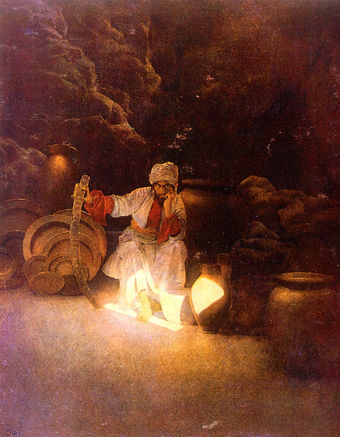
Painting of the Ali Baba story in The Book of One Thousand and One Nights by Maxfield Parrish
The introduction of paper in the 10th century enabled Islamic scholars to easily write manuscripts, including The Book of One Thousand and One Nights. Arab scholars also saved classic works of antiquity by translating them into various languages.
Christians (particularly Nestorian Christians) contributed to the Arab Islamic civilization during the Ummayad and the Abbasid periods by translating works of Greek philosophers to Syriac and then to Arabic. During the 4th through the 7th centuries, scholarly work in the Syriac and Greek languages was either newly initiated or carried on from the Hellenistic period. Many classic works of antiquity might have been lost if Arab scholars had not translated them into Arabic and Persian and later into Turkish, Hebrew, and Latin. Islamic scholars also absorbed ideas from China and India, and in turn Arabic philosophic literature contributed to the development of modern European philosophy.
Ibn Rushd
Ibn Rushd, also known by his Latinized name Averroës (April 14, 1126–December 10, 1198), was an Al-Andalus Muslim polymath, a master of Aristotelian philosophy, Islamic philosophy, Islamic theology, Maliki law and jurisprudence, logic, psychology, politics, Andalusian classical music theory, medicine, astronomy, geography, mathematics, physics, and celestial mechanics. Averroes was born in Córdoba, Al-Andalus, present-day Spain, and died in Marrakesh, present-day Morocco.
The 13th-century philosophical movement based on Averroes’ work is called Averroism. Both Ibn Rushd and the scholar Ibn Sina played a major role in saving the works of Aristotle, whose ideas came to dominate the non-religious thought of the Christian and Muslim worlds. Ibn Rushd has been described as the “founding father of secular thought in Western Europe.” He tried to reconcile Aristotle’s system of thought with Islam. According to him, there is no conflict between religion and philosophy; rather they are different ways of reaching the same truth. He believed in the eternity of the universe. Ibn Ruhd also held that the soul is divided into two parts, one individual and one divine; while the individual soul is not eternal, all humans at the basic level share one and the same divine soul.
Science and Mathematics
The Arabs assimilated the scientific knowledge of the civilizations they had conquered, including the ancient Greek, Roman, Persian, Chinese, Indian, Egyptian, and Phoenician civilizations. Scientists recovered the Alexandrian mathematical, geometric, and astronomical knowledge, such as that of Euclid and Claudius Ptolemy.
Persian scientist Muhammad ibn Mūsā al-Khwārizmī significantly developed algebra in in his landmark text, Kitab al-Jabr wa-l-Muqabala, from which the term “algebra” is derived. The term “algorithm” is derived from the name of the scholar al-Khwarizmi, who was also responsible for introducing the Arabic numerals and Hindu-Arabic numeral system beyond the Indian subcontinent. In calculus, the scholar Alhazen discovered the sum formula for the fourth power, using a method readily generalizable to determine the sum for any integral power. He used this to find the volume of a paraboloid.
Medicine
Medicine was a central part of medieval Islamic culture. Responding to circumstances of time and place, Islamic physicians and scholars developed a large and complex medical literature exploring and synthesizing the theory and practice of medicine. Islamic medicine was built on tradition, chiefly the theoretical and practical knowledge developed in India, Greece, Persia, and Rome. Islamic scholars translated their writings from Syriac, Greek, and Sanskrit into Arabic and then produced new medical knowledge based on those texts. In order to make the Greek tradition more accessible, understandable, and teachable, Islamic scholars organized the Greco-Roman medical knowledge into encyclopedias.
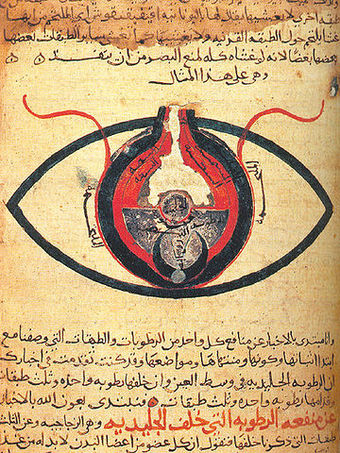
The eye, according to Hunain ibn Ishaq
Scholars developed large encyclopedias of medical knowledge during the Islamic Golden Age, such as this one from a manuscript dated circa 1200.
Art
Ceramics, glass, metalwork, textiles, illuminated manuscripts, and woodwork flourished during the Islamic Golden Age. Manuscript illumination became an important and greatly respected art, and portrait miniature painting flourished in Persia. Calligraphy, an essential aspect of written Arabic, developed in manuscripts and architectural decoration.
Arabesque
Typically, though not entirely, Islamic art depicts nature patterns and Arabic calligraphy, rather than figures, because many Muslims feared that the depiction of the human form is idolatry and thereby a sin against God, forbidden in the Quran. There are repeating elements in Islamic art, such as the use of geometrical floral or vegetal designs in a repetition known as the arabesque. The arabesque in Islamic art is often used to symbolize the transcendent, indivisible, and infinite nature of God. Mistakes in repetitions may be intentionally introduced as a show of humility by artists who believe only God can produce perfection, although this theory is disputed.
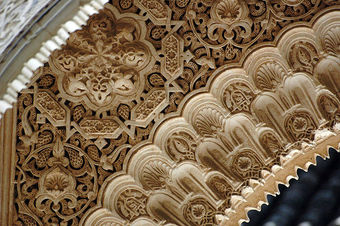
Detail of arabesque decoration at the Alhambra in Spain
Arabesque in Islamic art is often used to symbolize the transcendent, indivisible, and infinite nature of God.
Calligraphy
The traditional instrument of the Arabic calligrapher is the qalam, a pen made of dried reed or bamboo. Qalam ink is often in color, and chosen such that its intensity can vary greatly, so that the greater strokes of the compositions can be very dynamic in their effect. Islamic calligraphy is applied on a wide range of decorative mediums other than paper, such as tiles, vessels, carpets, and inscriptions. Before the advent of paper, papyrus and parchment were used for writing.
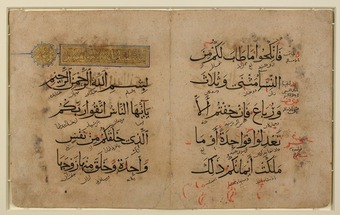
Qur’an manuscript Surat al-Nisa
Coins were another support for calligraphy. Beginning in 692, the Islamic caliphate reformed the coinage of the Near East by replacing visual depiction with words. This was especially true for dinars, or gold coins of high value, which were inscribed with quotes from the Quran.
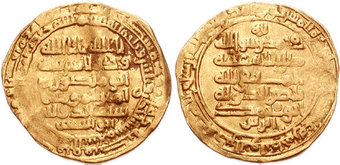
Hamdanid gold dinar
10th-century Syria
By the 10th century, the Persians, who had converted to Islam, began weaving inscriptions on elaborately patterned silks. These calligraphic-inscribed textiles were so precious that Crusaders brought them to Europe as prized possessions. A notable example is the Suaire de Saint-Josse, used to wrap the bones of St. Josse in the abbey of St. Josse-sur-Mer near Caen in northwestern France.
Architecture and Tilework
There were many advances in architectural construction, and mosques, tombs, palaces, and forts were inspired by Persian and Byzantine architecture. Islamic mosaic art anticipated principles of quasicrystalline geometry, which would not be discovered for 500 more years. This art used symmetric polygonal shapes to create patterns that can continue indefinitely without repeating. These patterns have even helped modern scientists understand quasicrystals at the atomic levels.
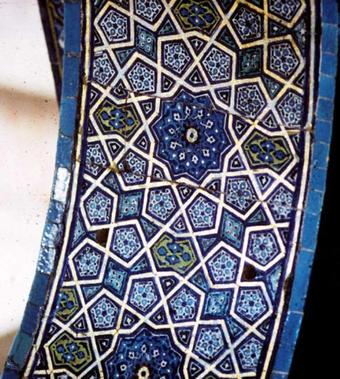
Mosque Archway
Geometric patterns: an archway in the Sultan’s lodge in the Ottoman Green Mosque in Bursa, Turkey (1424), its girih strapwork forming 10-point stars and pentagons.
10.3.5: The Abbasid Empire
The Abbasid Caliphate was the third of the Islamic caliphates to succeed the Islamic prophet Muhammad in 750 CE, and ruled over a large, flourishing empire for three centuries.
Learning Objective
Discuss the political stability during the Abbasid Era and the Abbasids’ rise to power
Key Points
- The Abbasids overthrew the Umayyad dynasty in 750 CE, supporting the mawali, or non-Arab Muslims, by moving the capital to Baghdad in 762 CE.
- The Persian bureaucracy slowly replaced the old Arab aristocracy as the Abbasids established the new positions of vizier and emir to delegate their central authority.
- The Abbasids maintained an unbroken line of caliphs for over three centuries, consolidating Islamic rule and cultivating great intellectual and cultural developments in the Middle East in the Golden Age of Islam.
- The Fatimid dynasty broke from the Abbasids in 909 and created separate line of caliphs in Morocco, Algeria, Tunisia, Libya, Egypt, and Palestine until 1171 CE.
- Abbasid control eventually disintegrated, and the edges of the empire declared local autonomy.
- Though lacking in political power, the dynasty continued to claim authority in religious matters until after the Ottoman conquest of Egypt in 1517.
Key Terms
- mawali
-
Non-Arab Muslims.
- Fatimid dynasty
-
A Shi’a Islamic caliphate that spanned a large area of North Africa, from the Red Sea in the east to the Atlantic Ocean in the west; they claimed lineage from Muhammad’s daughter.
- emir
-
A title of high office used in a variety of places in the Muslim world.
- vizier
-
A high-ranking political advisor or minister in the Muslim world.
Rise of the Abbasid Empire (c. 750 CE)
The Umayyad dynasty was overthrown by another family of Meccan origin, the Abbasids, in 750 CE. The Abbasids distinguished themselves from the Umayyads by attacking their moral character and administration. In particular, they appealed to non-Arab Muslims, known as mawali, who remained outside the kinship-based society of the Arabs and were perceived as a lower class within the Umayyad empire. The Abbasid dynasty descended from Muhammad’s youngest uncle, Abbas ibn Abd al-Muttalib (566–653 CE), from whom the dynasty takes its name. Muhammad ibn ‘Ali, a great-grandson of Abbas, began to campaign for the return of power to the family of Muhammad, the Hashimites, in Persia during the reign of Umar II, an Umayyad caliph who ruled from 717–720 CE.
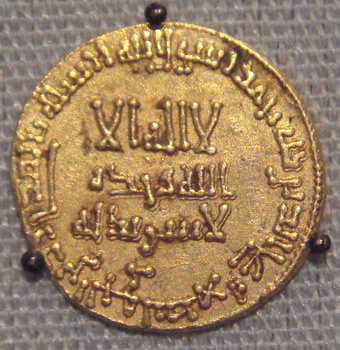
Coin of the Abbasids, Baghdad, Iraq, 765 CE
Power in Baghdad
The Abbasids moved the empire’s capital from Damascus, in modern-day Syria, to Baghdad, in modern-day Iraq, in 762 CE. The Abbasids had depended heavily on the support of Persians in their overthrow of the Umayyads, and the geographic power shift appeased the Persian mawali support base. Abu al-‘Abbas’s successor, Al-Mansur, welcomed non-Arab Muslims to his court. While this helped integrate Arab and Persian cultures, it alienated the Arabs who had supported the Abbasids in their battles against the Umayyads. The Abbasids established the new position of vizier to delegate central authority, and delegated even greater authority to local emirs. As the viziers exerted greater influence, many Abbasid caliphs were relegated to a more ceremonial role as Persian bureaucracy slowly replaced the old Arab aristocracy.
The Abbasids, who ruled from Baghdad, had an unbroken line of caliphs for over three centuries, consolidating Islamic rule and cultivating great intellectual and cultural developments in the Middle East in the Golden Age of Islam. By 940 CE, however, the power of the caliphate under the Abbasids began waning as non-Arabs gained influence and the various subordinate sultans and emirs became increasingly independent.
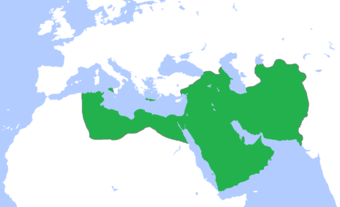
Map of the Abbasid Caliphate at its greatest extent, c. 850 CE
The Abbasid dynasty ruled as caliphs from their capital in Baghdad, in modern Iraq, after taking over authority of the Muslim empire from the Umayyads in 750 CE.
Decline of the Abbasid Empire
The Abbasid leadership worked to overcome the political challenges of a large empire with limited communication in the last half of the 8th century (750–800 CE). While the Byzantine Empire was fighting Abbasid rule in Syria and Anatolia, the caliphate’s military operations were focused on internal unrest. Local governors had begun to exert greater autonomy, using their increasing power to make their positions hereditary. Simultaneously, former supporters of the Abbasids had broken away to create a separate kingdom around Khorosan in northern Persia.
Several factions left the empire to exercise independent authority. In 793 CE, the Shi’a (also called Shi’ite) dynasty of Idrisids gained authored over Fez in Morocco. The Berber Kharijites set up an independent state in North Africa in 801 CE. A family of governors under the Abbasids became increasingly independent until they founded the Aghlabid Emirate in the 830s. Within 50 years, the Idrisids in the Maghreb, the Aghlabids of Ifriqiya, and the Tulunids and Ikshidids of Misr became independent in Africa.
By the 860s governors in Egypt set up their own Tulunid Emirate, so named for its founder Ahmad ibn Tulun, starting a dynastic rule separate from the caliph. In the eastern territories, local governors decreased their ties to the central Abbasid rule. The Saffarids of Herat and the Samanids of Bukhara seceded in the 870s to cultivate a more Persian culture and rule. The Tulinid dynasty managed Palestine, the Hijaz, and parts of Egypt. By 900 CE, the Abbasids controlled only central Mesopotamia, and the Byzantine Empire began to reconquer western Anatolia.
The Fatimid Caliphate (909–1171 CE)
Several factions challenged the Abbasids’ claims to the caliphate. Most Shi’a Muslims had supported the Abbasid war against the Umayyads because the Abbasids claimed legitimacy with their familial connection to Muhammad, an important issue for Shi’a. However, once in power, the Abbasids embraced Sunni Islam and disavowed any support for Shi’a beliefs.
The Shiʻa Ubayd Allah al-Mahdi Billah of the Fatimid dynasty, who claimed descent from Muhammad’s daughter, declared himself Caliph in 909 CE and created a separate line of caliphs in North Africa. The Fatimid caliphs initially controlled Morocco, Algeria, Tunisia, and Libya, and they expanded for the next 150 years, taking Egypt and Palestine. The Abbasid dynasty finally challenged Fatimid rule, limiting them to Egypt. By the 920s, a Shi’a sect that only recognized the first five Imams and could trace its roots to Muhammad’s daughter Fatima, took control of Idrisi and then Aghlabid domains. This group advanced to Egypt in 969 CE, establishing their capital near Fustat in Cairo, which they built as a bastion of Shi’a learning and politics. By 1000 CE, they had become the chief political and ideological challenge to Abbasid Sunni Islam. At this point, the Abbasid dynasty had fragmented into several governorships that were mostly autonomous, although they official recognized caliphal authority from Baghdad. The caliph himself was under “protection” of the Buyid Emirs, who possessed all of Iraq and western Iran, and were quietly Shi’a in their sympathies.
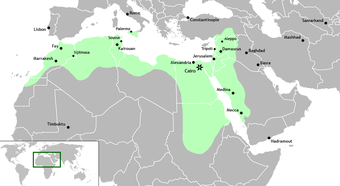
The Fatimid Caliphate at its height, c. 969 CE
The Fatimid dynasty broke from the Abbasids in 909 CE and created separate lines of caliphs in Morocco, Algeria, Tunisia, Libya, Egypt, and Palestine until 1171 CE.
Outside Iraq, all the autonomous provinces slowly became states with hereditary rulers, armies, and revenues. They operated under only nominal caliph authority, with emirs ruling their own provinces from their own capitals. Mahmud of Ghazni took the title of “sultan,” instead of “emir,” signifying the Ghaznavid Empire’s independence from caliphal authority, despite Mahmud’s ostentatious displays of Sunni orthodoxy and ritual submission to the caliph. In the 11th century, the loss of respect for the caliphs continued, as some Islamic rulers no longer mentioned the caliph’s name in the Friday khutba, or struck it off their coinage. The political power of the Abbasids largely ended with the rise of the Buyids and the Seljuq Turks in 1258 CE. Though lacking in political power, the dynasty continued to claim authority in religious matters until after the Ottoman conquest of Egypt in 1517.
